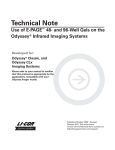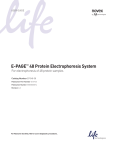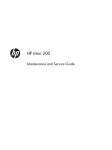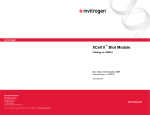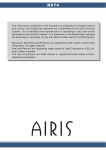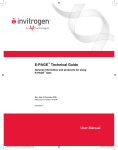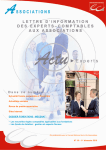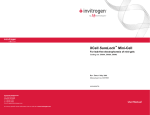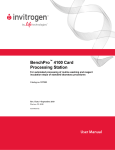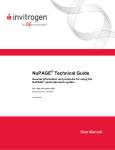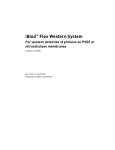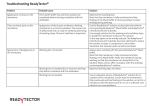Download User Manual - Thermo Fisher Scientific
Transcript
Novex® Semi-Dry Blotter For semi-dry electroblotting of proteins from polyacrylamide and agarose gels Catalog no. SD1000 Version A 10 July 2006 25-0949 Corporate Headquarters Invitrogen Corporation 1600 Faraday Avenue Carlsbad, CA 92008 T: 1 760 603 7200 F: 1 760 602 6500 E: [email protected] For country-specific contact information visit our web site at www.invitrogen.com User Manual ii Table of Contents Safety Information....................................................................................................................................... v Product Components and Specifications ................................................................................................ vi Additional Products.................................................................................................................................. vii Introduction ................................................................................................................... 1 Overview .......................................................................................................................................................1 Methods ......................................................................................................................... 4 Semi-Dry Blotting Procedure......................................................................................................................4 Post-Transfer .................................................................................................................................................9 Troubleshooting..........................................................................................................................................10 Appendix...................................................................................................................... 12 Purchaser Notification ...............................................................................................................................12 Technical Support.......................................................................................................................................13 iii iv Safety Information Safety Only use the Novex® Semi-Dry Blotter with a ground-isolated external DC power supply. This power supply should be equipped with No Load or Open Circuit protection. Operating limits for the Novex® Semi-Dry Blotter are: Maximum Voltage Limit: 50 Volts DC Operating Temperature: 4-40ºC ® The Novex Semi-Dry Blotter is designed to be operated with the lid in place. If the lid is removed, the electrical connection will be broken. Do not attempt to use the blotter without the lid in place. The Novex® Semi-Dry Blotter is safe to use when operated in accordance with the instructions in this manual. Do not use or modify the blotter in a manner not specified in this manual. Alteration of the blotter will: • Void the warranty. • Create a potential safety hazard. Invitrogen is not responsible for any injury or damage caused by operating this blotter in a manner not specified in this manual. All repairs and service should be performed by Invitrogen. The Novex® Semi-Dry Blotter is classified as Class II for protection against electrical shock. Important To ensure safe, reliable operation, always operate the Novex® Semi-Dry Blotter according to instructions provided in this manual. Wear protective gloves and safety glasses when working in a laboratory environment. Invitrogen is not responsible for injuries or damages caused by improper use. Informational Symbols The symbols used on the Novex® Semi-Dry Blotter are explained below: Indicates an area on the blotter where a potential shock hazard may exist. Indicates a warning. Consult the user manual to avoid possible personal injury or instrument damage. v Product Components and Specifications List of Components The components included with the Novex® Semi-Dry Blotter are listed below. Components Quantity ® Upon Receiving the Instrument Novex® Semi-Dry Blotter Specifications Important vi Novex Semi-Dry Blotter 1 Semi-Dry Blotter Cable, Red (Anode) 1 Semi-Dry Blotter Cable, Black (Cathode) 1 Semi-Dry Blotter Knobs 3 Examine the unit carefully for any damage incurred during transit. Any damage claims must be filed with the carrier. The warranty does not cover in-transit damage. Voltage Limit: 50 VDC Dimensions: 29 × 29 × 4 cm Transfer Area: 21 × 21 cm Shipping Weight: 8 pounds Lid Material: Acrylic Base Material: Acrylic Anode Conductive Plate: Platinum-coated titanium Cathode Conductive Plate: Polished stainless steel Cables: Insulated copper conductors Operating Temperature: 4-40°C Do not use ethanol or other organic solvents to clean the Novex® Semi-Dry Blotter. Organic solvents can cause acrylic to crack. Rinse the blotter with deionized water after each use to clean and let air dry. If you must wipe the surface, take particular care not to scratch or otherwise damage the platinumcoated titanium plate. Additional Products Additional products for western blotting are available separately from Invitrogen. Ordering information is provided below. For more information, visit our Web site at www.invitrogen.com or call Technical Service (page 12). Additional Products Blotter Spare Parts Quantity Catalog no. ® 1 SD0004 ® 1 SD0005 ® 1 SD0006 ® 1 SD0007 Blotting Filter Paper, 2.5 mm thick, 8.6 × 13.5 cm 50 LC2008 Nitrocellulose membranes, 0.20 µm pore size, 8.5 × 13.5 cm 0.45 µm pore size, 8.5 × 13.5 cm 20 20 LC2009 LC2006 Invitrolon™ PVDF/Filter Paper Sandwich, 0.45 µm pore size, 8.6 × 13.5 cm 20 LC2007 Blotting Filter Paper, 2.5 mm thick, 7.5 × 8.4 cm 50 LC2010 Nitrocellulose membrane, 0.20 µm pore size, 7.3 × 8.3 cm 0.45 µm pore size, 7.3 × 8.3 cm 20 20 LC2000 LC2001 Invitrolon™ PVDF/Filter Paper Sandwich, 0.45 µm pore size, 8.3 × 7.3 cm 0.20 µm pore size, 8.3 × 7.3 cm 20 20 LC2005 LC2002 Nylon membrane/filter paper sandwich, 0.45 µm pore size, 8.3 × 7.3 cm 20 LC2003 15 ml NP0005 NuPAGE Tris-Glycine Transfer Buffer (20X) 125 ml 1L NP0006 NP0006-1 NuPAGE® Transfer Buffer (25X) 500 ml LC3675 1L LC6675 1L LC6060 SYPRO Ruby Protein Blot Stain Kit 10–40 blots S-11791 SYPRO® Rose Plus Protein Blot Stain Kit 10–40 blots S-12011 Novex Semi-Dry Blotter Cable, Red Novex Semi-Dry Blotter Cable, Black Novex Semi-Dry Blotter Knob Novex Semi-Dry Blotter Screw Filter Papers and Membranes Midi Gels and E-PAGE™ gels Mini Gels Buffers and Reagents NuPAGE® Antioxidant ® ® Novex TBE Running Buffer (5X) Staining SimplyBlue™ SafeStain ® Continued on next page vii Additional Products, continued Additional Products, continued Immunodetection ® WesternBreeze Chromogenic Western Blot Detection Kit Quantity Catalog no. 1 Kit WB7103 (αMouse) 1 Kit WB7105 (αRabbit) WesternBreeze® Chemiluminescent Western Blot Detection Kit 1 Kit WB7104 (αMouse) 1 Kit WB7106 (αRabbit) Other Hardware Blotting roller, 8.6 cm wide 1 LC2100 Incubation tray, 10 × 14 cm 8 LC2102 Gel Knife 1 E19019 ZOOM® Dual Power Supply (100-120 VAC, 50/60 Hz) 1 ZP10001 ZOOM® Dual Power Supply (220-240 VAC, 50/60 Hz) 1 ZP10002 ® 1 EI8600 ® 1 EI8700 iBlot™ Dry Blotting System 1 IB1001 IB1001UK IB1001EU XCell II™ Blot Module 1 EI9051 PowerEase 500 Power Supply (100-120 VAC, 50/60 Hz) PowerEase 500 Power Supply (220/240 VAC, 50/60 Hz) Related Instruments Pre-cast Gels and Pre-made Buffers A large variety of pre-cast gels, including NuPAGE® Novex® Tris-Glycine Mini and Midi Gels and E-PAGE™ Gels, is available from Invitrogen. For details, contact Technical Support (page 13) or visit www.invitrogen.com. Other Blotting Systems from Invitrogen Invitrogen also has the following blotting systems: viii • The iBlot™ Dry Blotting System allows for fast, dry western blotting of proteins from various types of gels without the need to prepare buffers. The proteins transferred using the iBlot™ Dry Blotting System exhibit higher immunodetection sensitivity compared with proteins transferred using conventional semi-dry or semi-wet blotting methods. • The XCell II™ Blot Module is a semi-wet system for blotting up to two Mini Gels, and is designed to be inserted into the XCell SureLock™ Mini-Cell in place of the gel/buffer core assembly. Introduction Overview Introduction Western electroblotting is the electrophoretic transfer of separated proteins in a gel to the surface of a thin support membrane matrix, where they are bound and immobilized. Semi-dry blotting is performed with plate electrodes in a horizontal configuration, sandwiching a gel and membrane between sheets of buffer-soaked filter paper that function as the ion reservoir. During electrophoretic transfer, negatively charged molecules migrate out of the gel and move towards the positive electrode, where they are deposited on the membrane. The plate electrodes, separated only by the gel and filter paper stack, provide high field strength (V/cm) across the gel, allowing for very efficient, rapid transfers. The Novex® Semi-Dry Blotter is a semi-dry blotting system that allows you to quickly and easily perform simultaneous western blotting of up to 2 Midi Gels, 4 Mini Gels, or 2 E-PAGE™ gels. It can also be used to perform northern (RNA) and Southern (DNA) blotting. The Novex® Semi-Dry Blotter is designed for fast set-up and ease of use. The platinum-coated titanium anode plate and stainless steel cathode plate provide fast and efficient electroblotting using less transfer buffer than wet (tank) blotting methods. Novex® Semi-Dry Blotter Disassembled: Lid Cathode Plate Anode Plate Assembled: Black (Cathode) Cable Red (Anode) Cable Continued on next page 1 Overview, continued Features The Novex® Semi-Dry Blotter has the following features: • Simple, easy-to-use design • Allows simultaneous transfer of 1–2 Midi Gels, 1–4 Mini Gels, or 1–2 E-PAGE™ gels • Requires less transfer buffer than wet blotting methods • Connector design prevents incorrect cable hookups Novex® Semi-Dry Blotter Cables The Novex® Semi-Dry Blotter cables will fit onto the blotter in only one orientation, to prevent incorrect connection to the electrodes. The black (cathode) cable has a white acrylic safety ring attached to the end to prevent connection to the recessed red (anode) connector. Power Supply Requirements The Novex® Semi-Dry Blotter is used with an external DC power supply that must: • Be isolated from the ground so that the DC output is floating • Be equipped with No Load or Open Circuit protection • Be able to operate at 20 V The ZOOM® Dual Power Supply and PowerEase® 500 Power Supply are compatible for use with this blotter. See page vii for ordering information. Blotting Membranes Invitrogen offers three types of blotting membrane and filter paper sandwiches. Refer to page vii for ordering information. • Nitrocellulose for western or Southern blotting • PVDF (polyvinylidene difluoride) for western blotting • Nylon for Southern or northern blotting See the following table for more details on each membrane. Membrane Properties Nitrocellulose Most widely used membrane for western blotting Good binding capacity Proteins bind to the membrane due to hydrophobic interactions Protein binding capacity: 80 µg/cm2 Applications Pore size Reprobing Western transfer Amino acid analysis Solid phase assay systems 0.2 µm 0.45 µm No Continued on next page 2 Overview, continued Blotting Membranes, continued Membrane Properties Applications Pore size Reprobing PVDF Higher binding capacity than nitrocellulose Strong hydrophobic character and solvent resistant Physically stronger than nitrocellulose Compatible with commonly used protein stains and immunodetection methods Protein binding capacity: 50-150 µg/cm2 Protein sequencing Western transfer Amino acid analysis Solid phase assay systems 0.2 µm 0.45 µm Yes Nylon Microporous membrane modified with strongly basic charged groups Ideal for binding negatively charged biomolecules such as DNA and RNA Low background for enhanced resolution Membrane is formed around a nonwoven polyester fiber matrix which confers high tensile strength, toughness, and flexibility Southern and northern transfers Solid phase immobilization Dry chemistry test strips Enzyme immobilization Gene probe assays 0.45 µm Yes 3 Methods Semi-Dry Blotting Procedure This section provides guidelines and a protocol for the western blotting of proteins. It also includes buffer formulations and information for northern and Southern blotting. Materials Needed • Methanol • Transfer Buffer (see buffer recipes on the following pages for details) • NuPAGE® Antioxidant (for reduced samples) • Blotting membranes: MEND Northern and Southern Blotting o Nitrocellulose or PVDF membrane for western transfers (Nitrocellulose/Filter Paper Sandwiches and Invitrolon™/Filter Paper Sandwiches are available separately from Invitrogen) o Nylon membrane for northern or Southern transfers (available separately from Invitrogen) • 4 pieces of 2.5-mm thick Blotting Filter Paper per gel (available separately from Invitrogen), or equivalent pieces of thinner blotting filter paper • E-PAGE™ Gels only: E-PAGE™ Blotting Pads (included with gels) • Blotting roller (available separately from Invitrogen) • Deionized water • Shallow trays for equilibrating membranes, gels, filter paper, and blotting pads (Incubation Trays are available separately from Invitrogen) • Gel • Gel knife • Wear gloves at all times during the entire blotting procedure to prevent contamination of gels and membranes, to avoid exposure to irritants commonly used in electrophoresis and blotting procedures, and to avoid staining the anode plate with oils in your skin. • The platinum-plated titanium anode plate is easily scratched and should be handled with care. • Do not adjust the pH of the Transfer Buffer, as this may alter the conductivity of the solution. ION AT RECOM Introduction Northern and Southern blotting may be performed using the same blotter components and configuration (lid, cables, knobs) as western blotting. No special blotter components are required. Continued on next page 4 Semi-Dry Blotting Procedure, continued Transfer Buffer for Western Blots Prepare the appropriate transfer buffer for your gel type from the recipes below. For semi-dry western blotting, the transfer buffer must be at twice the concentration used in wet blotting (i.e., 2X) to ensure that there are enough buffering ions present in the smaller volume of liquid. NuPAGE® Novex® Bis-Tris or Tris Acetate Gels, and E-PAGE™ 48 Gels Prepare the following 2X NuPAGE® Transfer Buffer. This transfer buffer maintains the neutral pH environment established during gel electrophoresis, protects against modification of the amino acid side chains, and is compatible with N-terminal protein sequencing using Edman degradation. A volume of 500 ml is sufficient for blotting 1 Midi Gel or 2 Mini Gels. ® NuPAGE Transfer Buffer (20X) NuPAGE® Antioxidant Methanol Deionized Water Reduced 50 ml 0.5 ml 50 ml to 500 ml Non-reduced 50 ml — 50 ml to 500 ml E-PAGE™ 96 Gels Prepare the following 2X NuPAGE® Transfer Buffer without methanol. A volume of 500 ml is sufficient for blotting 1 E-PAGE™ 96 gel. NuPAGE® Transfer Buffer (20X) NuPAGE® Antioxidant Deionized Water Reduced 50 ml 0.5 ml to 500 ml Non-reduced 50 ml — to 500 ml Novex® Tris Glycine or Tricine Gels Prepare the following 2X Tris-Glycine Transfer Buffer. A volume of 500 ml is sufficient for blotting 1 Midi Gel or 2 Mini Gels. Tris-Glycine Transfer Buffer (25X) Methanol Deionized Water Transfer Buffer for Southern Blots 40 ml 50 ml to 500 ml Prepare the appropriate transfer buffer for DNA agarose and polyacrylamide gels from the recipes below. 1X Tris-Borate EDTA (TBE) Transfer Buffer A volume of 500 ml is sufficient for blotting 1 Midi Gel or 2 Mini Gels. Note that a 0.5X concentration may also be used. Novex® TBE Running Buffer (5X) Deionized Water pH 8.3 100 ml to 500 ml 1X Tris Acetate EDTA (TAE) Transfer Buffer A volume of 500 ml is sufficient for blotting 1 Midi Gel or 2 Mini Gels. 10X Tris Acetate-EDTA (0.4 Tris Acetate, 0.01 disodium EDTA) Deionized Water pH 8.0 50 ml to 500 ml Continued on next page 5 Semi-Dry Blotting Procedure, continued Transfer Buffer for With its high buffering capacity and low ionic strength, the following 1X NAQ Northern Transfer Buffer is more efficient than TAE, TBE, or MOPS for transfer Northern Blots of RNA from agarose gels. A volume of 500 ml is sufficient for blotting 1 Midi Gel or 2 Mini Gels. 50X NAQ Northern Transfer Buffer (0.2 M MOPS, 50 mM sodium acetate, 5 mM EDTA, pH 7.0) Deionized Water Equilibrating the Gel 10 ml to 500 ml Equilibrating the gel in transfer buffer removes salts that may increase conductivity and heat during transfer. Be careful to equilibrate for the recommended time, as longer equilibration can result in protein diffusion. 1. After electrophoresis, remove the gel from the cassette. 2. Place the gel in a shallow tray containing 100 ml (for Midi Gels and E-PAGE™ Gels) or 50 ml (for Mini Gels) of the appropriate Transfer Buffer. Equilibrate for 10 minutes on an orbital shaker. E-PAGE™ gels: Remove the gel from the transfer buffer and gently rub a gloved finger over the well side of the gel to remove small gel pieces from the gel surface. Re-submerge the gel in transfer buffer to rinse away any gel pieces adhering to the gel, as they can cause air bubbles and field distortion during transfer. Preparing the Blotting Membrane Nitrocellulose or Nylon 1. Use a pre-cut membrane or cut a membrane to the appropriate size for your gel. 2. Soak the membrane in the appropriate Transfer Buffer for a few minutes in a shallow tray. PVDF Gel Layout 1. Use a pre-cut Invitrolon™/Filter Paper Sandwich or cut a PVDF membrane to the appropriate size for your gel. 2. Pre-wet the membrane for 30 seconds in methanol, ethanol, or isopropanol. Briefly rinse the membrane in deionized water. 3. Soak the membrane in the appropriate Transfer Buffer for a few minutes in a shallow tray. We recommend using the following gel layouts in the blotter, to ensure even pressure of the plates on the gel stack. Single gel (Mini or Midi) Two gels (Mini or Midi) Three gels (Mini) Four gels (Mini) Continued on next page 6 Semi-Dry Blotting Procedure, continued Compression of the Gel Stack If you are blotting only one Mini Gel, the weight of the cathode plate lid alone will apply enough pressure to maintain good gel/membrane contact. If you are blotting Midi Gels or two or more Mini Gels, it is necessary to slightly tighten the knobs on the Novex® Semi-Dry Blotter to ensure even pressure of the plates on the gel stack(s). Tighten the knobs as described in the following protocol. It is important that the pressure on the gel stack(s) be even without being too firm. Tighten the knobs roughly evenly with regard to torque, not necessarily with regard to rotational distance. Too little compression can allow proteins to migrate between the gel and membrane, causing protein band smearing. Too much compression can distort the gel. You can apply a small piece of tape to one of the bumps on each knob to make it easier to determine the rotational distance. Semi-Dry Blotting Protocol Follow the instructions below to blot 1–2 Midi Gels or 1–4 Mini Gels using the Novex® Semi-Dry Blotter: 1. In a shallow tray, briefly soak 2 stacked pieces of 2.5-mm thick Blotting Filter Paper in the appropriate Transfer Buffer. Several pieces of thinner blotting paper can be used to produce a stack of equivalent thickness. 2. Remove any air bubbles trapped between the filter paper sheets by rolling the stack with a blotting roller while it is still submerged in buffer. Note: Removing air bubbles is essential, as they can block the transfer of biomolecules. 3. Place the stack of pre-soaked Blotting Filter Paper on the anode plate of the Novex® Semi-Dry Blotter. Remove any air bubbles between the paper and plate by rolling the stack with the blotting roller. 4. Place the pre-soaked blotting membrane on top of the Blotting Filter Paper stack and remove any air bubbles with the blotting roller. 5. Carefully remove the gel from the transfer buffer and place on top of the blotting membrane. (E-PAGE™ gels: Place the flat side of the gel on the blotting membrane such that the well side of the gel is facing up.) Gently remove any air bubbles with the blotting roller or a wet gloved finger. Note: Be careful not to disturb the gel after it has been placed on the membrane. Moving the gel can result in protein smearing on the membrane. Optional: To physically support the gel, making it easier to pick up and move, place a piece of thin filter paper (included with the membrane/filter paper sandwiches from Invitrogen) on top of the gel in the transfer buffer. Do not fully submerge the paper in buffer; a small amount of buffer on top of the gel will allow the paper to lightly adhere to the gel surface. Then carefully slide a gel knife under one corner of the gel and lift the gel/filter paper out of the tray. After the gel has been placed on the blotting membrane, gently peel away the thin filter paper. Protocol continued on next page Continued on next page 7 Semi-Dry Blotting Procedure, continued Semi-Dry Blotting Protocol, continued Protocol continued from previous page 6. E-PAGE™ Gels only: Fill the wells of the gel with Transfer Buffer after it has been placed on the stack. Soak the E-PAGE™ Blotting Pad in Transfer Buffer, forcing air out of the pad by pressing it with a gloved finger, and then place E-PAGE™ Blotting Pad on the gel and gently roll out air bubbles. 7. Briefly soak the remaining 2 stacked pieces of 2.5-mm thick Blotting Filter Paper in the appropriate Transfer Buffer. Remove any air bubbles with the blotting roller while the stack is still submerged in buffer. 8. Place the stack of pre-soaked Blotting Filter Paper on the gel. Ensure that the filter paper sheets are aligned properly and flush with the gel/membrane sandwich. Gently remove any air bubbles with the blotting roller. 9. Repeat Steps 1–8 for each gel you are blotting. When finished, make sure there are no puddles of buffer on the anode plate. 10. Place the cathode plate lid on the stack, taking care to properly align the lid holes with the screws and the anode plate electrical connector. Be careful not to disturb the blot sandwich. 11. If you are blotting only one Mini Gel, the weight of the cathode plate lid alone will apply enough pressure to maintain good gel/membrane contact. For two or more Mini Gels, or if you are blotting Midi Gels or E-PAGE™ gels, thread the knobs onto the blotter screws and spin them down until they just make contact with the lid. Then tighten the knobs another ½ to 1 turn, depending on the number of gels in the blotter (the greater the number of gels, the more tightening required). Note: Tighten the knobs roughly evenly with regard to torque, not necessarily with regard to the number of turns. Do not overtighten. 12. Connect the power cables from the blotter to the power supply, making sure that the red-to-red and black-to-black connections are correct. 13. Mini or Midi Gels: Transfer at 20 V for 30–60 minutes. E-PAGE™ Gels: Transfer at 25 V for 30–60 minutes. (The transfer time may vary depending on the properties of the proteins, and should be determined empirically.) 14. Proceed to Post-Transfer, next page. 8 Post-Transfer Post-Transfer Disassembly and Cleaning To disassemble the blotter and gel stack: 1. Remove the knobs and lift off the lid of the Novex® Semi-Dry Blotter. 2. Carefully separate the membrane from the blotting stack and proceed with post-transfer analysis (see below). The gel may be retained for posttransfer staining. 3. Rinse the Novex® Semi-Dry Blotter with deionized water and air dry after each use. For repairs and service, contact Technical Service (page 12). Post Transfer Analysis After transfer, you may proceed to immunodetection, store the membrane for future use, or stain the membrane. • For immunodetection of proteins, use the WesternBreeze® Chromogenic or Chemiluminescent Immunodetection Kits available from Invitrogen (page vii) or any other immunodetection kit. • For storing nitrocellulose membranes, air dry the membrane and store the membrane in an air-tight plastic bag or dish at room temperature or 4ºC. Avoid storing nitrocellulose below -20ºC, as it may turn brittle. • For storing PVDF membranes, air dry the membrane and store in an airtight plastic bag or dish at room temperature, 4ºC, or -80ºC. When you are ready to use the membrane, re-wet the membrane with methanol for a few seconds, followed by thorough rinsing of the membrane with deionized water to remove methanol. • For staining membranes after blotting, you may use any total protein membrane staining methods such as Coomassie® Blue R-250, Ponceau S, Amido Black, SYPRO® Ruby Protein Blot Stain, or SYPRO® Rose Plus Protein Blot Stain (page vii). You may also use SimplyBlue™ SafeStain with dry PVDF membranes; to avoid high background, do not use SimplyBlue™ SafeStain on nitrocellulose and wet PVDF membranes. • If you do not detect any proteins on the membrane after immunodetection or staining, refer to Troubleshooting on page 10. Refer to the immunodetection kit manufacturer’s recommendations for optimizing immunodetection. 9 Troubleshooting Introduction Review the information below to troubleshoot your experiments using the Novex® Semi-Dry Blotter. Problem Transfer efficiency is poor Cause Solution Voltage is too low 1-mm thick polyacrylamide gels (mini and Midi Gels) should be transferred at 20 V, E-PAGE™ Gels at 25 V (approximately 15 V/cm field strength). Power supply is inappropriate for semidry transfer Some power supplies will shut off or blow a fuse when run at the conditions required for semi-dry transfer. Semi-dry transfer requires low voltage (20 V) and high current. Check with the manufacturer of the power supply to determine whether it is appropriate for semi-dry transfer. Transfer performed for too short a time Increase the amount of time for transfer. Typical transfer times range from 30 to 60 minutes. Transfer sandwich was assembled in the wrong order The Novex® Semi-dry Blotter is configured with the cathode on the top, and anode on the bottom. This results in a downward transfer of proteins from the gel onto the membrane. Follow the instructions carefully when assembling the transfer sandwich. The pH of the transfer buffer is too close to the isoelectric point of the protein The transfer buffers should be at the optimal pH if prepared as described in this manual. Do not adjust the pH with acid or base as this will increase the conductivity of the buffer and result in higher current during transfer. Too much methanol in the transfer buffer Reducing the amount of methanol can help elute proteins from the gel, but can reduce binding to nitrocellulose membranes. High-percentage gels restrict transfer Higher percentage acrylamide or crosslinkers can restrict elution of proteins. Use the lowest percentage acrylamide possible to separate your proteins. Puddles of buffer were present on the plates, allowing the current to bypass the stack Always clean up the lower plate before closing the lid of the transfer apparatus. Do not squeeze the stack excessively, as this removes transfer buffer from the blotting paper and also creates puddles that the current can pass through. Continued on next page 10 Troubleshooting, continued Problem Cause Solution Air spaces are interfering with contact between the gel and the membrane Roll the membrane with a blotting roller (or a clean test tube or pipet) before placing the gel on the membrane, then remove any air bubbles between the gel and membrane with a blotting roller or a wet gloved finger. Transfer will not occur where the gel is not in contact with the membrane. Electrophoretic conditions were incorrect or not ideal Running conditions, sample preparation, percentage acrylamide, and many other variables can affect the migration and resolution of proteins. Please review your electrophoresis conditions. Under- or overcompression of gel Follow the compression guidelines in this manual. Too little compression can allow proteins to migrate between the gel and membrane, causing protein band smearing. Too much compression can distort the gel. All membranes Insufficient binding of proteins to the membrane Nitrocellulose membrane Insufficient binding of proteins to the membrane Over-transfer through Use 0.2-µM pore size nitrocellulose instead the membrane of 0.45 µM, or use PVDF with a higher binding capacity. Not enough methanol in the transfer buffer Increase the concentration of methanol. Low molecularweight proteins are not binding well or are being washed away Use glutaraldehyde to crosslink the proteins to the membrane and use Tween-20 in the wash steps. SDS is included in the transfer buffer Do not use SDS in the transfer buffer. Membrane was dried out before it was added to the transfer sandwich Membrane should be completely gray and slightly translucent when added to the sandwich. If it has dried out, rewet in methanol and equilibrate in transfer buffer. Alcohol was not used to prewet the membrane PVDF is hydrophobic and requires a short soak in methanol or ethanol prior to transfer. Membrane was not thoroughly wetted. Always pre-wet the membrane according to the manufacturer’s instructions. White spots indicate dry areas of the membrane. Too much current Use a low conductivity transfer buffer such as those recommended in this manual. PVDF membrane Smeared or swirled transfer and missing bands Brown coloration of membrane or cracking of gel after transfer. 11 Appendix Purchaser Notification Warranty Limited Use Label License No. 5: Invitrogen Technology 12 Invitrogen warrants that this product will be free from defects in material and workmanship for a period of one (1) year from date of purchase. If a defect is present, Invitrogen will, at its option, repair, replace, or refund the purchase price of this product at no charge to you, provided it is returned during the warranty period. This warranty does not apply if the product has been damaged by accident, abuse, misuse, or misapplication, or from ordinary wear and tear. For your protection, items being returned must be insured against possible damage or loss. This warranty shall be limited to the replacement of defective products. It is expressly agreed that this warranty will be in lieu of all warranties of fitness and in lieu of the warranty of merchantability. The purchase of this product conveys to the buyer the non-transferable right to use the purchased amount of the product and components of the product in research conducted by the buyer (whether the buyer is an academic or forprofit entity). The buyer cannot sell or otherwise transfer (a) this product (b) its components or (c) materials made using this product or its components to a third party or otherwise use this product or its components or materials made using this product or its components for Commercial Purposes. The buyer may transfer information or materials made through the use of this product to a scientific collaborator, provided that such transfer is not for any Commercial Purpose, and that such collaborator agrees in writing (a) not to transfer such materials to any third party, and (b) to use such transferred materials and/or information solely for research and not for Commercial Purposes. Commercial Purposes means any activity by a party for consideration and may include, but is not limited to: (1) use of the product or its components in manufacturing; (2) use of the product or its components to provide a service, information, or data; (3) use of the product or its components for therapeutic, diagnostic or prophylactic purposes; or (4) resale of the product or its components, whether or not such product or its components are resold for use in research. Invitrogen Corporation will not assert a claim against the buyer of infringement of patents owned or controlled by Invitrogen Corporation which cover this product based upon the manufacture, use or sale of a therapeutic, clinical diagnostic, vaccine or prophylactic product developed in research by the buyer in which this product or its components was employed, provided that neither this product nor any of its components was used in the manufacture of such product. If the purchaser is not willing to accept the limitations of this limited use statement, Invitrogen is willing to accept return of the product with a full refund. For information on purchasing a license to this product for purposes other than research, contact Licensing Department, Invitrogen Corporation, 1600 Faraday Avenue, Carlsbad, California 92008. Phone (760) 603-7200. Fax (760) 602-6500. Email: [email protected] Technical Support Web Resources Contact Us Visit the Invitrogen website at www.invitrogen.com for: • Technical resources, including manuals, vector maps and sequences, application notes, MSDSs, FAQs, formulations, citations, handbooks, etc. • Complete technical service contact information • Access to the Invitrogen Online Catalog • Additional product information and special offers For more information or technical assistance, call, write, fax, or email. Additional international offices are listed on our website (www.invitrogen.com). Corporate Headquarters: Japanese Headquarters: European Headquarters: Invitrogen Corporation 1600 Faraday Avenue Carlsbad, CA 92008 USA Invitrogen Japan LOOP-X Bldg. 6F Tel: 1 760 603 7200 Minato-ku, Tokyo 108-0022 Invitrogen Ltd Inchinnan Business Park 3 Fountain Drive Paisley PA4 9RF, UK Tel (Toll Free): 1 800 955 6288 Tel: 81 3 5730 6509 Fax: 1 760 602 6500 Fax: 81 3 5730 6519 3-9-15, Kaigan E-mail: [email protected] E-mail: [email protected] Tel: +44 (0) 141 814 6100 Tech Fax: +44 (0) 141 814 6117 E-mail: [email protected] ©2006 Invitrogen Corporation. All rights reserved. For research use only. Not intended for any animal or human therapeutic or diagnostic use. 13 Notes: Corporate Headquarters Invitrogen Corporation 1600 Faraday Avenue Carlsbad, CA 92008 T: 1 760 603 7200 F: 1 760 602 6500 E: [email protected] For country-specific contact information visit our web site at www.invitrogen.com User Manual























